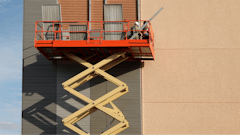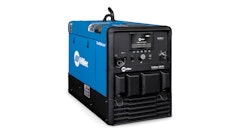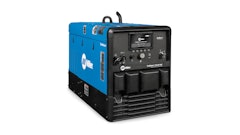Most every rental center has at least one sod cutter and some have a whole fleet, standing ready to clear space for a flower garden, a walkway, or just to harvest sod from one area for transplant to the next.
There are three basic types of sod cutters - the manual, "kick-plow" type; the tractor-mount sod harvester type (for large areas); and the self-propelled, walk-behind type, which is the variety most rental centers stock.
The manual, "kick-plow" type sod cutter depends on the user for all its power. As the name suggests, you kick it to cut the sod, and continue until A) you get the row finished, or B) you give up and go back to the rental center for a self-propelled unit.
The tractor mount, sod harvester unit is very efficient, but also is too large and unwieldy for homeowner use. It is literally designed for a sod farm, and wide open spaces.
This leaves the self-propelled sod cutter as the most common in use in rental today. Although some rental centers stock kick plows for those too stingy to rent a self-propelled unit - chances are, the self-propelled type is the one your customers will be looking for.
Selecting a sod cutter
When it comes to selecting a sod cutter, Rose Mary Becker, national sales manager for Classen Mfg., says the self-propel system is an important consideration. "You will want to choose a sod cutter with front-drive wheels that are actually self driven, versus models where the wheels are only friction driven or not driven at all. The drive wheels are one of the hardest working items on a sod cutter, therefore, it is important to look for models with larger, wider wheels."
In addition, she says, choose a model where the blade is positioned between the front and rear wheels, which will result in a more consistent cutting thickness. Models where the blade is positioned at the rear of the machine can deliver a less consistent cutting thickness, Becker says.
Richard Borland of Bluebird points out that "Bluebird has a powered reverse to make unloading easier. The user can use a ramp and let the machine do the work going up or down." Of course, regardless of what type machine you're renting, be prepared to provide a trailer or ramps at the least. As Bob Brophy of Turfco points out, "Many times a contractor will send one person after a sod cutter, so it has to be easy to handle."
This leads to the next consideration in a sod cutter - is it easy to operate? Brophy notes, for example, that "even contractors are looking for equipment that anyone can run. The growing number of females on construction crews requires equipment that is less cumbersome and easier to handle. Commercial landscapers are hiring more baby boomers and equipment must be easier to operate and less labor intensive for this group."
Of course, when you're renting to homeowners, the same conditions apply. After all, the whole point in renting a piece of equipment is to get the job done easier.
Borland points out that comfort features are important as well. "We offer rubber-mounted anti-vibration handles," he says. "Our (machine) has easy-to-read depth and gear selection decals to assist first-time users."
Here he has hit upon an excellent point. Regardless of the "gee whiz" features of the sod cutter you're considering, it is of no help to your bottom line if your customers don't understand how to operate the unit. As with other pieces of rental equipment, ease of operation should be a major consideration when deciding what to buy. Remember, most homeowners rent equipment in order to simplify a job, or to save money. Likewise, many contractors are employing laborers that might not have had experience with every type of machine. Making sure you have a machine that is user friendly can increase your bottom line.
"One should look for a sod cutter that places the primary controls right at the operator's fingertips," Becker advises. "Select models with a throttle design that allows variable speed, yet is designed with the safety of being able to stop all moving parts when released."
Brophy adds, "Another thing I've heard many times from store owners is that they want a machine that does not scare customers away. They rent a big complicated machine to a customer (especially a do-it-yourselfer) and he brings it back, turns it in and says nothing or just mumbles as he turns it in. You know he will not be back. The machine scared him or beat him up and he will tell everyone about how mean it was." Of course, if you choose your equipment wisely, the opposite will be true - your customer will be happy with his rental and spread the news.
One way to ensure this is to buy machines specifically designed for the rental market. Sod cutters live a hard life, especially when they're used in a rental fleet. You'll want machines that are easy to start, stop and operate. Large, easy-to-read placards or decals with operating instructions are a must, and you might want to consider making operating instructions available in Spanish as well.
The money saved by buying an unproven or unfamiliar machine is quickly eaten up in lost customers. It pays to ask, as Brophy says, "Who am I buying from? Is it a company that has been around for a long while, or is it an offshore outfit that could be gone tomorrow? Check on parts availability. If it is not easy to use and service, I wouldn't buy it."
Regardless of who made the machine or how well it's made, sooner or later, it will break down. The time to determine parts availability is before you buy the machine, not when it breaks down in July and your parts supplier tells you it will be September before you get your parts. As with all rental equipment, the service after the sale is the most important part of the transaction.
There are other things to consider as well. Self-propelled sod cutters come in various widths of cut, and as Becker points out, "Ninety percent of all walk-behind sod cutters purchased are models designed with an 18-inch cutting width. Ideally, you would want to look for models that offer optional cutting widths from 12 up to 24 inches and are easy to convert back and forth."
Conversion may not be a bad idea, because as Brophy says, some folks shouldn't be cutting and carrying 24-inch-wide strips of sod. "Most sod removal is in small square foot increments; say under 200 square feet at a time," he says. "So a high-production unit that cuts 12 to 16,000 square feet per hour is not needed. In the past, contractors just sent the guy to pick up an 18-inch sod cutter because he was buying 18-inch wide sod from the farm. Today sod comes in all widths from the sod farms, from 12 to 48 inches wide. What size is coming off the lawn is not important."
Brophy adds, "What is important to today's commercial lawn and landscape contractors is work related injuries. Twelve-inch sod is 50 percent lighter than 18-inch wide sod, and less likely to hurt the help." Also, it is less likely to throw out your customer's back.
Caring for your cutter
Finally, there are maintenance concerns. The blade on a sod cutter literally takes a beating every day of its life. It must be inspected after each rental for tightness, sharpness and alignment. Also, the multitude of grease fittings on these machines require regular attention. Failure to keep a machine that lives in the dirt properly lubricated is a recipe for disaster.
Borland notes that site preparation also plays a role in the life of a sod cutter. They cannot be expected to cut hard, dry ground, for instance. "This may require watering the ground the night before. The soil has to be moist. You cannot force a sod cutter when in a cut," he says.
Aside from common sense instruction with each rental, a regular maintenance plan, including lubrication of the chassis, inspection of controls for proper operation and engine maintenance are a must in order to get the most return on your investment. When looking at sod cutters, look at them through the customer's eyes. Is it easy to operate/start? Does it do a good job? Are the instructions easy to understand? Finally, ask yourself if the sod cutter is easy to maintain and if parts are readily available. If the machine in question meets these requirements, you have found the machine for your fleet.




























